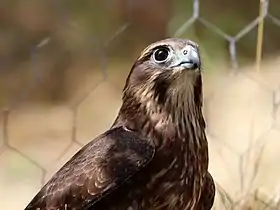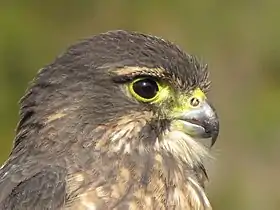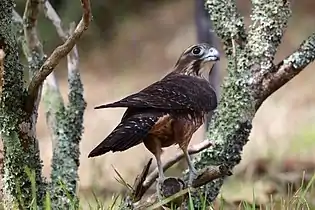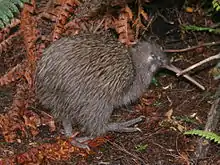| New Zealand falcon | |
|---|---|
 | |
| Male falcon | |
| Scientific classification | |
| Domain: | Eukaryota |
| Kingdom: | Animalia |
| Phylum: | Chordata |
| Class: | Aves |
| Order: | Falconiformes |
| Family: | Falconidae |
| Subfamily: | Falconinae |
| Genus: | Falco |
| Species: | F. novaeseelandiae |
| Binomial name | |
| Falco novaeseelandiae Gmelin, JF, 1788 | |
The New Zealand falcon (Māori: kārearea or kāiaia; Falco novaeseelandiae) is New Zealand's only falcon. Other common names for the bird are bush hawk and sparrow hawk. It is frequently mistaken for the larger and more common swamp harrier. It is the country's most threatened bird of prey, with only around 3000–5000 breeding pairs remaining.[3][4]

Taxonomy
The New Zealand falcon was formally described in 1788 by the German naturalist Johann Friedrich Gmelin in his revised and expanded edition of Carl Linnaeus's Systema Naturae. He placed it with the falcons and eagles in the genus Falco and coined the binomial name Falco novaeseelandiae.[5] Gmelin based his description on the "New-Zealand falcon" that had been described and illustrated in 1781 by the English ornithologist John Latham. Latham had examined specimens both in the British Museum and in the Leverian Museum.[6]
Ornithologists variously described the New Zealand falcon as an aberrant hobby or as allied to three South American species – F. deiroleucus (orange-breasted falcon), F. rufigularis (bat falcon), and F. femoralis (aplomado falcon); molecular phylogenetic studies show that it is most closely related to the aplomado falcon.[7] Two forms are apparent from their significantly different sizes, with the larger race in the South Island and the smaller in the North Island. Although neutral genetic markers show a recent history of these two forms, the substantial size difference is likely to be driven by ecological adaptation. Conservation management had already avoided mixing of the North Island (Falco novaeseelandiae ferox) and South Island (Falco novaeseelandiae novaeseelandiae) populations.[8]
Description
With a wingspan between 63 cm (25 in) and 98 cm (39 in)[3] and weight rarely exceeding 450 g (16 oz), the New Zealand falcon is slightly over half the size of the swamp harrier, which it usually attacks on sight. (Unlike the swamp harrier, the New Zealand falcon catches other birds in flight, and rarely eats carrion.) The male is about two-thirds the weight of the female.[9]
Distribution and habitat
The New Zealand falcon is mainly found in heavy bush and the steep high country in the South Island, and is rarely seen north of a line through the central area of the North Island. A small population also breeds on the Auckland Islands; the species is known from the Chatham Islands from fossil remains.
Behaviour
An aggressive bird that displays great violence when defending its territory, the New Zealand falcon has been reported to attack dogs, as well as people.
.jpg.webp)
Breeding
The New Zealand falcon nests in a scrape in grassy soil or humus in various locations: under a rock on a steep slope or on a rock ledge, among epiphytic plants on a tree branch, or under a log or branch on the ground,[10][11] or on bare ground,[12] making the two or three eggs that they lay vulnerable to predators such as stray cats, stoats, weasels, possums, and wild dogs.
Food and feeding
In common with other falcons, the prey of the New Zealand falcon is mostly other birds, such as pigeons, parakeets, seabirds and pheasants. However, it is opportunistic and will also take stoats, hares and rabbits. It also preys upon insects, including cicadas, beetles and dragonflies. It will sometimes feed on carrion.[13]
Relationship with humans
Falconry
The Wingspan National Bird of Prey Centre in the Ngongotahā Valley is a captive breeding facility and visitor centre. Wingspan undertakes conservation, education and research activities related to birds of prey found in New Zealand, and provides demonstrations of falconry.[14]
Falcons for Grapes programme
In 2005, funding was given by the Ministry of Agriculture and Forestry towards a programme that uses the falcons to control birds that damage grapes and act as pests in vineyards as well as monitoring the birds and establishing a breeding population in the vicinity of the Marlborough wine region.[15] Initially, four falcons were relocated to the vineyards from the surrounding hills. After the release of a further 15 birds breeding began to occur – the first time it is thought to have happened since land clearance 150 years ago.
Cardrona Kārearea Conservation Project
The Cardrona Valley in the South Island has a small population of kārearea. The five-year project that started in 2019 will focus on collecting data on the kārearea to gather knowledge of sightings, locate breeding pairs, locate and monitor nests, and gain insights on breeding population, habitat use, and territory size.[16][17][18][19]
Illegal shooting
New Zealand falcon are fully protected under the Wildlife Act 1953. However, there are many reported instances of falcons being illegally shot. The founder of Wingspan, Debbie Stewart, says: “Most of the birds we get in here have been shot. It’s criminal.” She has also said that human activities lead to the deaths of three-quarters of falcons in their first year. Both Stewart and the Department of Conservation have claimed that people shooting New Zealand falcons have interests in chickens or racing pigeons.[4][20][21]
Electrocution threat

Another ongoing threat to the birds from human activity is electrocution.[22][23] Both a five-year radio tracking study[24] of released birds in Marlborough and an observational study in Glenorchy[25] have attributed nearly half of the bird deaths to electrocution on 11,000 volt distribution transformers and structures.
Cultural references
The New Zealand falcon features on the reverse of the New Zealand $20 note and has twice been used on New Zealand stamps. It was also featured on a collectable $5 coin in 2006.[26]
The Royal New Zealand Air Force's aerobatic team is called the Black Falcons.[27]
The proverb "Me te kopae kārearea" or "like the nest of kārearea" means 'rarely seen'.[28]
The kārearea was voted Bird of the Year winner in 2012.[29][30] The Forest & Bird competition aims to raise awareness about New Zealand's native birds, their habitats, and the threats they face.[31]

Gallery
- New Zealand falcon/Karearea





See also
References
- ↑ BirdLife International (2022). "Falco novaeseelandiae". IUCN Red List of Threatened Species. 2022: e.T22696476A208302635. Retrieved 23 July 2022.
- ↑ "Appendices | CITES". cites.org. Retrieved 14 January 2022.
- 1 2 Douglas, Rob; Barea, Laurence; Waite, Ed; Hankin, Chris (20 June 2017). "How Good Design Can Protect the kārearea (New Zealand Falcon) and Improve Network Safety" (PDF). Electricity Engineers Association.
- 1 2 "New Zealand falcon/kārearea". Department of Conservation. Retrieved 1 September 2022.
- ↑ Gmelin, Johann Friedrich (1788). Systema naturae per regna tria naturae : secundum classes, ordines, genera, species, cum characteribus, differentiis, synonymis, locis (in Latin). Vol. 1, Part 1 (13th ed.). Lipsiae [Leipzig]: Georg. Emanuel. Beer. p. 268.
- ↑ Latham, John (1781). A General Synopsis of Birds. Vol. 1, Part 1. London: Printed for Leigh and Sotheby. p. 57, No. 38; Plate 4.
- ↑ Jérôme Fuchs; Jeff A Johnson; David P Mindell (23 September 2014). "Rapid diversification of falcons (Aves: Falconidae) due to expansion of open habitats in the Late Miocene". Molecular Phylogenetics and Evolution. 82 Pt A: 166–182. doi:10.1016/J.YMPEV.2014.08.010. ISSN 1055-7903. PMID 25256056. Wikidata Q30563770.
- ↑ Trewick SA, Olley L. 2016. Spatial size dimorphism in New Zealand’s last endemic raptor, the Kārearea Falco novaeseelandiae, coincides with a narrow sea strait. IBIS 158: 747–761
- ↑ Heather, Barrier; Robertson, Hugh (2005). The Field Guide of the Birds of New Zealand (Revised ed.). North Shore, New Zealand: Penguin Books. pp. 277–278. ISBN 978-0-14-302040-0.
- ↑ Marchant & Higgins 1993, p. 287.
- ↑ Robertson, C.J.R., ed. (1985). Reader's Digest Complete Book of New Zealand Birds. Surry Hills, NSW: Reader's Digest. pp. 154–155. ISBN 0-949819-97-2.
- ↑ Moon, Geoff. (2010). New Zealand forest birds and their world. Auckland, N.Z.: New Holland. p. 37. ISBN 9781869661960. OCLC 314752354.
- ↑ "New Zealand Falcon". The Peregrine Fund. Archived from the original on 24 September 2022. Retrieved 15 December 2022.
- ↑ James, Shauni (25 March 2022). "Wingspan continues to soar to new heights". NZ Herald. Retrieved 14 June 2022.
- ↑ "SFF Project Summary". Ministry of Agriculture and Forestry. Archived from the original on 22 May 2010. Retrieved 25 February 2010.
- ↑ "The Cardrona Kārearea Conservation Project". Queenstown NZ. 7 August 2020. Archived from the original on 15 August 2020. Retrieved 12 November 2020.
- ↑ "The Kārearea Project | Cardrona Foundation". Cardrona Alpine Resort. Archived from the original on 15 August 2020. Retrieved 12 November 2020.
- ↑ Waterworth, Kerrie (7 November 2020). "Karearea monitoring project taking off". Otago Daily Times Online News. Archived from the original on 7 November 2020. Retrieved 12 November 2020.
- ↑ Waterworth, Kerrie (27 April 2020). "'Unique' karearea programme providing insights". Otago Daily Times Online News. Archived from the original on 8 May 2020. Retrieved 12 November 2020.
- ↑ Marie-Brown, Jo (14 July 2000). "Falcons fall to pigeon fanciers". NZ Herald. Retrieved 1 September 2022.
- ↑ Yarwood, Vaughan (July–August 2018). "The hunters". New Zealand Geographic. 152: 104–105.
- ↑ "Falcons Return to Wairau Plain". Ministry of Agriculture and Forestry (press release). 13 December 2007. Archived from the original on 23 May 2010. Retrieved 25 February 2010.
- ↑ "Protection sought for vineyard falcons". Radio New Zealand. 25 February 2010. Retrieved 25 February 2010.
- ↑ Fox; Wynn (2010). "The impact of electrocution on the New Zealand falcon (Falco novaeseelandiae)" (PDF). Notornis. 57 (2): 71–74.
- ↑ Waite, Ed (2017). "Causes of mortality for kārearea / New Zealand falcon (Falco novaeseelandiae) in the Whakatipu district". Notornis. 64: 21–23.
- ↑ 2006 New Zealand Falcon coin sets Archived 13 May 2006 at the Wayback Machine. Accessed 6 April 2006.
- ↑ "Air Force Black Falcons show off new T-6C Texan planes". Stuff. 19 November 2015. Retrieved 1 September 2022.
- ↑ Murdoch, Riley (2001). Maori Bird Lore. Viking Sevenseas NZ. p. 72. ISBN 0854671005.
- ↑ "Raybon Kan backs a winner: NZ falcon wins Bird of the Year contest". Scoop. 10 October 2012. Archived from the original on 12 November 2020. Retrieved 12 November 2020.
- ↑ "Karearea NZ Falcon 2012 Bird of The Year Winner | New Zealand Falcon Karearea". www.wingspan.co.nz. Archived from the original on 7 November 2020. Retrieved 12 November 2020.
- ↑ "Bird of the Year - Frequently asked questions". www.birdoftheyear.org.nz. Archived from the original on 16 January 2020. Retrieved 12 November 2020.
Cited sources
- Marchant, S.; Higgins, P.J., eds. (1993). "Falco novaeseelandiae New Zealand Falcon" (PDF). Handbook of Australian, New Zealand & Antarctic Birds. Vol. 2, Raptors to lapwings. Melbourne, Victoria: Oxford University Press. pp. 279–291. ISBN 978-0-19-553069-8.
Further reading
- Crichton, Sandy (May 2009), "On a wing and a prayer", Forest & Bird, pp. 21–25
- Seaton, Richard (2007), The ecological requirements of the New Zealand falcon (Falco novaseelandiae) in plantation forestry (PDF), Massey Research Online, hdl:10179/658, Wikidata Q112870851
- Andrew Christopher Wyllie Thomas (2008), The behaviour and development of New Zealand falcons (Falco novaeseelandiae) nesting in a plantation forest (PDF), Massey Research Online, hdl:10179/3160, Wikidata Q112878413
External links
- Wingspan Birds of Prey Trust - The national centre for the conservation, education and advocacy of birds of prey in New Zealand. Location: Rotorua, NZ.
- Raptor Association of New Zealand
- New Zealand Falcon New Zealand Birds Online
- New Zealand falcon/Kārearea at Department of Conservation (New Zealand)
- New Zealand Falcon at Birdlife International
- New Zealand falcon at Te Ara: The Encyclopedia of New Zealand
- Assessment of the potential for the integration of New Zealand falcon conservation and vineyard pest management
- Marlborough Falcon Conservation Trust
- Raptor Alliance for New Zealand
- New Zealand falcon discussed on RNZ Critter of the Week, 1 June 2018

